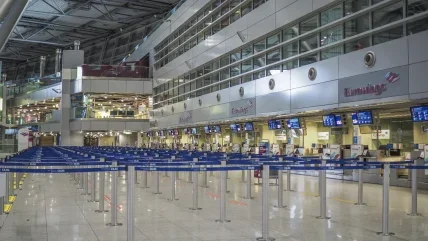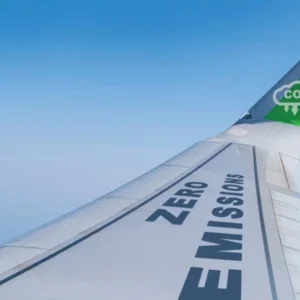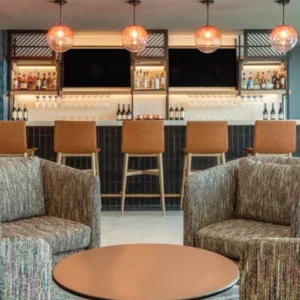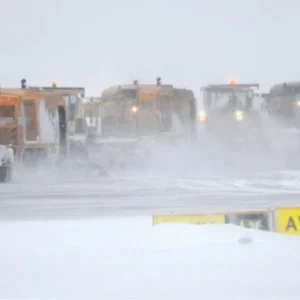
The Covid-19 pandemic brought many things to light, but key among them was the role that airports play as focal points not just for travel, but also for infection. With that in mind, airport operators are re-evaluating every aspect and touchpoint of their operations to ensure a clean, safe and healthy environment for both passengers and employees.
This had led to the implementation of measures from social distancing procedures and enforced mask wearing, making hand sanitiser readily available, and also increasing deep cleaning across operations. And for some airports, those deep cleaning procedures have been taken a step further, incorporating a new technology into the mix – ultraviolet light.
Specifically, cleaning technologies are now using ultraviolet C (UVC), which is ultraviolet radiation with wavelengths between 200–290nm. UVC light technology can prove especially useful in areas with high footfall that require regular, fast decontamination. It’s already been used by hospital hygiene professionals for the past few years to rapidly decontaminate sluices, storage areas and waiting rooms.
The technology works by filling an area with UVC light, which breaks down the lipid outer layer of an organism, such as a coronavirus, and destroys the genetic material within it. In optimum settings, UVC technology can decontaminate spaces and reduce pathogens by up to 99.99%. Compared with manual cleaning, using UVC as part of an automated decontamination programme has proven far more efficient at eradicating viral pathogens, making it hugely beneficial in the wake of the pandemic.
New cleaning technologies
“Enhanced cleaning processes have a significant impact on travel safety and comfort,” acknowledges Sami Kiiskinen, vice-president of airport development at Finavia. Formerly known as the Finnish Civil Aviation Administration, Finavia is responsible for maintaining and developing Finland’s airport network. It manages 20 airports around the country, two of which focus solely on military and general aviation while the other 18 primarily serve commercial flights.
Chief among those is Helsinki Airport, the biggest and busiest airport in Finland by far – with 20 times the traffic of its closest counterpart, Oulu Airport. Roughly 90% of Finland’s total air traffic passes through Helsinki, making it the fourth busiest among Nordic countries as well. In 2019, Helsinki handled over 21.8 million passengers – of which 18.9 million were international and 2.9 million domestic.
In mid-2020, Helsinki Airport began piloting a range of UVC technologies for a variety of uses intended to combat the spread of Covid-19, including security control tray cleaning, automatic disinfection equipment embedded in tray conveyors, manual disinfection using a stand-alone UVC-station, and both mechanical and UVC escalator handrail cleaning.
“This new technology will help us intensify disinfection even further and improve cleaning standards. We will now be able to disinfect empty security control trays quickly after each use,” said Ulla Lettijeff, Helsinki Airport executive director for Finavia, in a press release at the time.
The UVC technology is supplied by the Finnish company LedFuture, among others, and includes an LED technology-based disinfection solution. The UVC-LED solution is energy efficient, environmentally friendly and quick in comparison with traditional cleaning methods, and it is based on research by the University of Helsinki, the University of Eastern Finland and the Finnish Institute for Health and Welfare (THL).
By mid-2020, the airport had already shorted cleaning cycles in the terminal premises in order to ensure cleaners surfaces and increased safety – something they had implemented at the very start of the pandemic. Similarly, enhanced mechanical washing of security control trays was rapidly implemented early in 2020, before the coronavirus had even hit Finland.
“As passenger numbers grow, enhanced cleaning is still one of the most important messages to combat Covid-19,” says Kiiskinen, acknowledging that as travel continues its recovery, new challenges will present themselves for airport operators.
In order to get ahead of it, Helsinki Airport today makes full use of automated equipment in its transfer passenger security control. Its new terminal extension is set to be finalised and become fully operational by summer 2022, and will include new “state-of-the-art” security control lines that will include UVC tray disinfection equipment, Kiiskinen adds.
A fresh coat
Beyond UVC, Helsinki has brought in a variety of other cleaning technologies to combat Covid-19 on-site. This includes Fotonit nanocoating, which greatly reduces the amount of viruses and bacteria on treated surfaces, such as check-in and bag drop kiosks, check-in and boarding gate counters, toilets and waiting area furniture. According to Kiiskinen, the coating is long-lasting, even though the furniture is wiped several times a day. Following successful trials of the technology throughout the summer, which was developed by technology company Nanoksi Finland, Finavia has now adopted the coating for use across the airport.
“The photocatalytic Fotonit coating effectively inactivates viruses and kills bacteria,” Kiiskinen explains. “The process is activated by light and air’s water vapour. Then the coating forms reactive oxygen compounds which are very short-lived, as they react with microbes and volatile organic compounds (VOCs) on the surface. As a result, in this nanoscale process the microbes and VOCs decompose. The method is thoroughly researched and studied, as well as non-toxic and safe for people.”
Based partly on same type of nanotechnology, Helsinki Airport has also implemented elevator air purifiers in its newest elevators. With photocatalytic oxidation – a technology developed by NASA for reducing contaminants from spacecraft cabins – it can reduce viruses and bacteria as well as odours and dust from elevators’ air.
As the pandemic has shown operators, it’s important to be able to react to unforeseen events and to be willing to try new things in order to mitigate negative affects – flexibility, in other words, is key, even if those new methods don’t always work out.
“We are always looking for new technologies to make travelling via our airports as smooth and pleasant as possible,” Kiiskinen explains. “During 2020 we have also piloted a copper-coated antimicrobial tape to reduce the amount of microbes on certain surfaces as door handles, hand rails, toilet buttons and so on. Even though this coating method didn’t result in wider use, it was a good exercise in order to find suitable health safety technologies in our environment.”
The drive for innovation
However, while the pandemic’s been a part of daily life for almost two years now, airport operations existed before Covid-19 and will exist long after the effects of the virus no longer hold the world in a vice-like grip. Even now, the grip has begun to loosen, though the fear of mutant variants and the threat they pose mean that the industry can’t afford to get complacent.
Beyond Covid-19, though, there are many other reasons why airports might want to reflect on their cleaning measures, and look to embrace and implement new technologies as and when they become available.
“In addition to passenger safety, the well-being, health and safety of airport employees are also important drivers,” says Kiiskinen. “In addition to coronaviruses, there are several other familiar microbes that cause many kinds of nuisance in societies. New technologies help us to reduce the impacts of these normal and less severe [pandemics] too. Also, general passenger satisfaction and confidence is naturally very important to us as an airport operator.”
His note about other epidemics is notable – in the years before Covid-19, the air travel industry and, indeed, society as a whole had a number of warning shots fired in the form of coronaviruses like SARS and MERS, and also Ebola. All three viruses resulted in severe pandemics that spread across multiple countries, but it wasn’t until Covid-19 that the 21st century witnessed a truly global pandemic.
For however long societies across the world have to contend with Covid-19, there will be other pandemics in the future, and so flexibility and a willingness to embrace new technologies will remain pivotal for airports.
Increased safety and confidence
Of the advantages offered by the new technologies Helsinki Airport has implemented into its operations, perhaps the most important is the “24/7 effect”, according to Kiiskinen. In other words, the nanocoatings and UVC disinfection equipment are constantly at work neutralising microbes, without the gaps between cleaning times characteristic of manual cleaning.
“Traditional cleaning is not able to wipe every surface every hour,” Kiiskinen explains, “so the technology is here to fill the gaps and hence improve overall safety.” This leaves less opportunity for viruses and bacteria to gather on a surface, and thereby come into contact with staff or passengers – an obvious benefit for any industry with high footfall, where new microbes could be introduced far faster than any manual cleaning could prevent.
With the implementation of these new technologies, Helsinki Airport has made a lot of ground in reducing risk to its passengers and employees, but also in helping to increase confidence in air travel through its doors and in the safety it can provide. One of the main challenges facing the air travel industry is the blow that Covid-19 has provided to passenger confidence, and one that it will have to continually weather as new strains and fears emerge. UVC light and the other cleaning technologies Helsinki has embraced provide a double benefit, then – not just tackling the issue itself, but also easing people’s fears around it.
“Even though we can’t have exact figures of the effects of these measures on passenger’s and staff member’s health, we see that the measures increase the overall comfort and confidence in using our facilities,” Kiiskinen says, with confidence. “For staff, the result is a more pleasant and safe working environment.”
While Helsinki Airport is the main location where Finavia has been focusing on integrating UVC technology, security control tray UVC disinfection is also in use at the Oulu and Rovaniemi airports. As with Helsinki, both airports have expressed satisfaction and confidence in how the technology has enhanced their cleaning services and helped to minimise the risk of infection for passengers and staff.
Technologies like UVC will help airports and other travel industries to mitigate the spread of viruses and bacteria on their sites. And with Covid-19 firmly intrenched in our lives for the foreseeable future, and the possibility of future pandemics an ever-present threat on the horizon, airport operators would do well to keep this in mind.
21.8 million
Number of passengers who travelled through Helsinki Airport in 2019.
Finavia
99.99%
Of pathogens can be eliminated by using UVC technology to decontaminate airport spaces.
Applied Sciences






